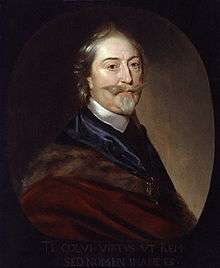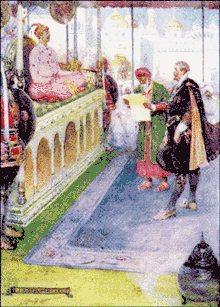Thomas Roe
| Sir Thomas Roe | |
|---|---|
 | |
| Born |
c. 1581 Low Leyton near Wanstead in Essex |
| Died | 6 November 1644 (aged 63) |
| Spouse(s) | Lady Eleanor Beeston |
| Parent(s) |
Sir Robert Rowe Elinor Jermy |
Sir Thomas Roe (c. 1581 – 6 November 1644) was an English diplomat of the Elizabethan and Jacobean periods. Roe's voyages ranged from Central America to India; as ambassador, he represented England in the Mughal Empire, the Ottoman Empire, and the Holy Roman Empire. He sat in the House of Commons at various times between 1614 and 1644. Roe was an accomplished scholar and a patron of learning.
Life

Roe was born at Low Leyton near Wanstead in Essex, the son of Sir Robert Rowe of Gloucestershire and Cranford, Middlesex, and his wife Elinor Jermy, daughter of Robert Jermy of Worstead, Norfolk. He matriculated at Magdalen College, Oxford, on 6 July 1593, at the age of twelve. In 1597 he entered Middle Temple[1] and became esquire of the body to Queen Elizabeth I of England. He was knighted by James I on 23 July 1604, and became friendly with Henry, Prince of Wales, and also with his sister Elizabeth, afterwards briefly Queen of Bohemia, with whom he maintained a correspondence and whose cause he championed.
In 1610, Roe was sent by Prince Henry on a mission to the West Indies, during which he visited Guiana and the Amazon River. He tried to reach the Lake Parime location of the fabled El Dorado, that was represented in the map of Thomas Harriot in 1596. However, he failed then, and in two subsequent expeditions, to discover the gold he was seeking.

In 1614, Roe was elected Member of Parliament for Tamworth.[1] From 1615 to 1618, he was ambassador to the court at Agra, India, of the Great Mughal Ruler, Jahangir. The principal object of the mission was to obtain protection for the East India Company`s factory at Surat. At the Mughal court, Roe allegedly became a favorite of Jahangir and may have been his drinking partner. This greatly enhanced Roe's status with the Mughals. His journal was a valuable source of information for the reign of Jahangir.
In 1621, Roe was elected MP for Cirencester.[1] He received diplomatic credentials to the Ottoman Empire on 6 September, arriving at Constantinople in December. In this role, he obtained an extension of the privileges of the English merchants. He concluded a treaty with Algiers in 1624, by which he secured the liberation of several hundred English captives. He also gained the support, by an English subsidy, of the Transylvanian Prince Bethlen Gabor for the European Protestant alliance and the cause of the Palatinate.
Through his friendship with the Ecumenical Patriarch of Constantinople, Cyril Lucaris, the famous Codex Alexandrinus was presented to James I,[2] and Roe himself collected several valuable manuscripts which he subsequently presented to the Bodleian Library. 29 Greek and other manuscripts, including an original copy of the synodal epistles of the council of Basle, he presented in 1628 to the Bodleian Library, after his letters of appointment had been revoked on 26 October 1627.[3] But Roe did not leave Porte until June 1628. A collection of 242 coins was given by his widow, at his desire, to the Bodleian Library after his death. He also searched for Greek marbles on behalf of the Duke of Buckingham and the second Earl of Arundel.[4]
In 1629, Roe was successful in another mission undertaken, to arrange a peace between Sweden and Poland. In so doing, he was able to help free up Gustavus Adolphus of Sweden to intervene decisively in the Thirty Years War on the side of the Protestant German princes. Roe also negotiated treaties with Danzig and Denmark, returning home in 1630, when a gold medal was struck in his honour. In 1631, he sponsored the Arctic exploration of Luke Fox; Roes Welcome Sound was named in his honor.[5]
In January 1637, Roe was appointed Chancellor of the Order of the Garter, with a pension of £1200 a year. Subsequently, he took part in the peace conferences at Hamburg, Regensburg and Vienna, and used his influence to obtain the restoration of the Palatinate, the emperor declaring that he had "scarce ever met with an ambassador till now." In June 1640, he was made a privy councillor. In November 1640 he was elected MP for Oxford University in the Long Parliament and sat until his death in 1644 at the age of about 63.[1] He was buried in the parish church of St. Mary in Woodford, London.
Family
Roe married Lady Eleanor Beeston, the young widowed daughter of Sir Thomas Cave of Stanford-on-Avon, Northamptonshire in 1614, just weeks before embarking for India.[6](see Cave-Browne-Cave baronets for the background of the family). Not going to India, his wife accompanied Roe on the subsequent embassy to Constantinople. The couple were childless and adopted an orphaned girl introduced by Queen Elizabeth of Bohemia. When Eleanor died in 1675 she was buried alongside him in the parish church of St. Mary, Woodford.[7]
Works



- The Embassy of Sir Thomas Roe to the Court of the Great Mogul, 1615-1619, as narrated in his journal and correspondence
His Embassy of Sir Thomas Roe to the Court of the Great Mogul, 1615-1619, as narrated in his journal and correspondence, several times printed, has been re-edited, with an introduction by William Foster, for the Hakluyt Society (1899). This is a valuable contribution to the history of India in the early 17th century.
- Negotiations in his Embassy to the Ottoman Porte, 1621–28, vol. i
Vol. i. was published in 1740, but the work was not continued. Other correspondence, consisting of letters relating to his mission to Gustavus Adolphus, was edited by SR Gardiner for the Camden Society Miscellany (1875), vol. vii., and his correspondence with Lord Carew in 1615 and 1617 by Sir F. Maclean for the same society in 1860.
- True and Faithful Relation ... concerning the Death of Sultan Osman ... (1622)
Several of his manuscripts are in the British Museum collections. Roe published a True and Faithful Relation ... concerning the Death of Sultan Osman ..., 1622; a translation from Paolo Sarpi,
- Discourse upon the Resolution taken in the Valteline (1628); and in 1613 Dr T Wright published Quatuor Colloquia, consisting of theological disputations between himself and Roe; a poem by Roe is printed in Notes and Queries, iv. Ser. v. 9.
- The Swedish Intelligencer (1632–33), including an account of the career of Gustavus Adolphus and of the Diet of Ratisbon (Regensburg), is attributed to Roe in the catalogue of the British Museum. Several of his speeches, chiefly on currency and financial questions, were also published. Two other works in manuscripts are mentioned by Wood: Compendious Relation of the Proceedings ... of the Imperial Diet at Ratisbon and Journal of Several Proceedings of the Order of the Garter.
Modern biography
There are two modern biographies, Itinerant Ambassador: the Life of Sir Thomas Roe by Michael J. Brown (University of Kentucky Press, Lexington, 1970) and Sir Thomas Roe 1581–1644. A Life by Michael Strachan (Michael Russell, Salisbury, Wiltshire, 1989).
References
| Wikimedia Commons has media related to Thomas Roe. |
- 1 2 3 4 W R Williams Parliamentary History of the County of Gloucester
- ↑ Negotiations, p. 618.
- ↑ Macray, Annals of the Bodleian, 2nd de., pp. 70, 72.
- ↑
 Lee, Sidney, ed. (1897). "Roe, Thomas". Dictionary of National Biography. 49. London: Smith, Elder & Co. p. 91.
Lee, Sidney, ed. (1897). "Roe, Thomas". Dictionary of National Biography. 49. London: Smith, Elder & Co. p. 91. - ↑ "JSTOR: The History of American Ornithology before Audubon". Retrieved 2008-04-09.
- ↑ Michael Strachan, Sir Thomas Roe 1581-1644. A Life, Michael Russell, Salisbury, Wiltshire, 1989, p. 58
- ↑ Strachan 1989, pp. 279-80
-
 This article incorporates text from a publication now in the public domain: Chisholm, Hugh, ed. (1911). "article name needed". Encyclopædia Britannica (11th ed.). Cambridge University Press.
This article incorporates text from a publication now in the public domain: Chisholm, Hugh, ed. (1911). "article name needed". Encyclopædia Britannica (11th ed.). Cambridge University Press.
| Parliament of England | ||
|---|---|---|
| Preceded by Sir Thomas Beaumont Sir John Ferrers |
Member of Parliament for Tamworth 1614 With: Sir Percival Willoughby |
Succeeded by Sir Thomas Puckering John Ferrers |
| Preceded by Sir Anthony Manie Robert Strange |
Member of Parliament for Cirencester 1621–1622 With: Thomas Nicholas |
Succeeded by Henry Poole Sir William Master |
| Preceded by Sir Francis Windebanke Sir John Danvers |
Member of Parliament for Oxford University 1640–1644 With: John Selden |
Succeeded by John Selden |
